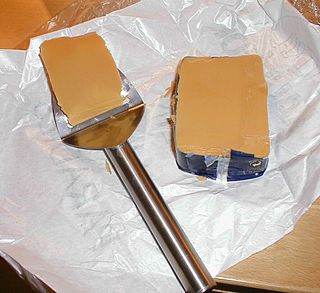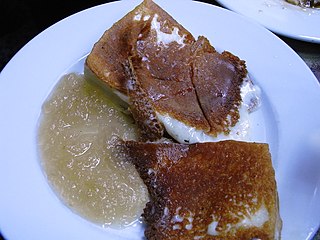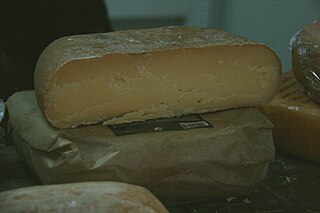
Brie is a soft cow's-milk cheese named after Brie, the French region from which it originated. It is pale in color with a slight grayish tinge under a rind of white mould. The rind is typically eaten, with its flavor depending largely upon the ingredients used and its manufacturing environment. It is similar to Camembert, which is native to a different region of France.

Brunost is a common, Norwegian name for mysost, a family of cheese-related foods made with whey, milk, and/or cream. It is often used to just refer to the Gudbrandsdalsost type, which is the most popular variety. Brunost is primarily produced and consumed in Norway. It is regarded as one of the country's most iconic foodstuffs, and is considered an important part of Norwegian gastronomical and cultural identity and heritage.

Goat cheese, goats' cheese, or chèvre, is cheese made from goat's milk.

Majorero is a goat milk cheese from Spain. Similar to Manchego, this firm cheese has a milky, nutty flavour that goes well with various pear products. It is pale white in colour, and comes in large wheels. Currently it is protected under European Law with Protected Designation of Origin (PDO) status.

Saint Agur is a blue cheese made from pasteurised cow's milk from the village of Beauzac in the Monts du Velay, part of the mountainous Auvergne region of central France. Developed in 1988 by the cheese company Bongrain, it is made from pasteurised cow's milk, enriched with cream, and contains 60% butterfat, qualifying it as a double-cream cheese. Aged for 60 days in cellars, the cheese becomes stronger and spicier as it ages.

Cheese is a dairy product derived from milk that is produced in a wide range of flavors, textures, and forms by coagulation of the milk protein casein. It comprises proteins and fat from milk, usually the milk of cows, buffalo, goats, or sheep. During production, the milk is usually acidified, and adding the enzyme rennet causes coagulation. The solids are separated and pressed into final form. Some cheeses have molds on the rind, the outer layer, or throughout. Most cheeses melt at cooking temperature.
Primost is a Norwegian cheese made from cow's milk which has a soft spreadable texture providing a semi-sweet taste. The sweetness is derived from caramelizing the milk sugars of the whey as it is made. It is also known as mysost.

Caprino is an Italian cheese traditionally made from whole or skim goat's milk. The name of the cheese derives from the Italian word for goat, capra. With modern methods of production, the cheese is made from cow's milk, as well, or a combination of both cow's and goat's milks. The two major styles of caprino are fresco (fresh) and stagionato (aged).

Derby cheese is a mild, semi-firm British cow's milk cheese made in Derbyshire with a smooth, mellow texture and a buttery flavour. Like most of the traditional British hard cheeses it was produced exclusively on farms and was typically sold at a younger age than its more famous cousins Cheddar and Cheshire. It has a pale, golden orange interior with a natural or waxed rind and ripens at between one and six months. In many respects Derby is similar to Cheddar in taste and texture, but with a softer body and slightly higher moisture content. When young it is springy and mild but as it matures subtle sweet flavours develop and the texture becomes firmer.

Types of cheese are grouped or classified according to criteria such as length of fermentating, texture, methods of making, fat content, animal milk, country or region of origin, etc. The method most commonly and traditionally used is based on moisture content, which is then further narrowed down by fat content and curing or ripening methods. The criteria may either be used singly or in combination, with no single method being universally used.

Saint-Félicien is a cow's milk cheese produced in the Rhône-Alpes region of France. In France, it is designated a dauphinois cheese, referring to the former French province Dauphiné where it originated. It is a close cousin of another dauphinois cheese, Saint-Marcellin, and bears a similar texture and taste, though it can be almost twice as large in diameter.
Kunik is a semi-aged, triple cream wheel cheese made from 25% Jersey cow cream and 75% goat's milk. It has an edible, bloomy white rind; a tangy, buttery flavor; and a thick, smooth, creamy texture. The addition of high-milkfat Jersey cow cream makes the cheese more rich and flavorful than a brie cheese, but less pungent than a pure goat cheese. According to one reviewer, "it may very well be the sexiest cheese in the U.S.A.".

Cheeses in Mexico have a history that begins with the Spanish conquest, as dairy products were unknown in pre-Columbian Mesoamerica. The Spanish brought dairy animals, such as cattle, sheep, and goats, as well as cheesemaking techniques. Over the colonial period, cheesemaking was modified to suit the mixed European and indigenous tastes of the inhabitants of New Spain, varying by region. This blending and variations have given rise to a number of varieties of Mexican cheeses. These are most popular in the country, although European cheeses are made, as well. Almost all cheese in Mexico is made with cows’ milk, with some made from goats’ milk. More recently, efforts have been made to promote sheep’s milk cheeses. Most cheeses are made with raw (unpasteurized) milk. Cheeses are made in the home, on small farms or ranches, and by major dairy product firms. Between 20 and 40 different varieties of cheese are made in Mexico, depending on how one classifies them. Some, such as Oaxaca and panela, are made all over Mexico, but many are regional cheeses known only in certain sections on the country. Some of the least common are in danger of extinction.
Bluebell Falls Goats Cheese is an organic, handmade, soft goat's milk cheese with a creamy texture made in County Cork, Ireland.

Mallorca cheese is a Spanish cheese made exclusively on the island of Mallorca, one of the Balearic Islands in the Mediterranean Sea. It has Protected Designation of Origin and is made from the pasteurized milk of cows, goats and/or sheep which live on the island. The cheeses are slightly tapering, flat cylinders which measure 12–20 cm (5-8 inches) across and 7-9 cm (3-4 inches) high. They weigh from 750 g to 4 kg (1.5-9 lbs). Mallorca cheese is produced in three types:
Ardsallagh Goat Farm is located at Carrigtwohill County Cork. Three types of cheese are made from their own herd and from locally sourced goat's milk. The cheeses are suitable for vegetarians.

Brined cheese, also sometimes referred to as pickled cheese for some varieties, is cheese that is matured in a solution of brine in an airtight or semi-permeable container. This process gives the cheese good stability, inhibiting bacterial growth even in warmer climates. Brined cheeses may be soft or hard, varying in moisture content, and in colour and flavour, according to the type of milk used; though all will be rindless, and generally taste clean, salty and acidic when fresh, developing some piquancy when aged, and most will be white.
















